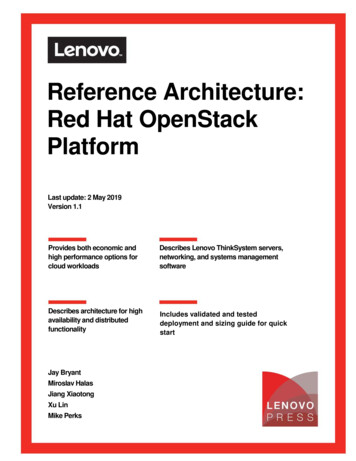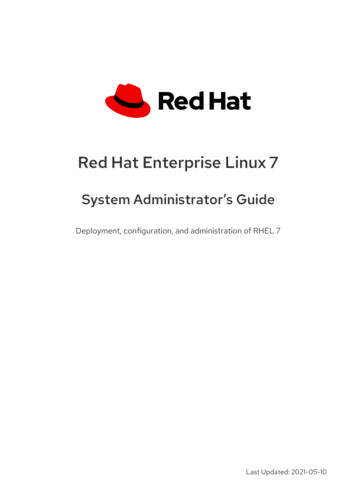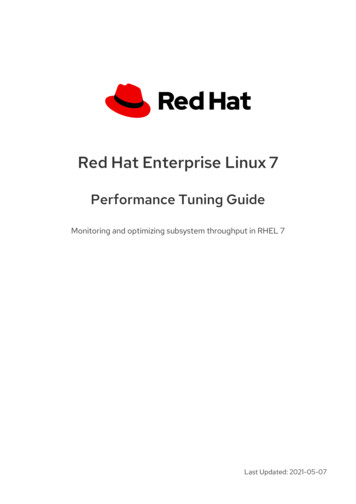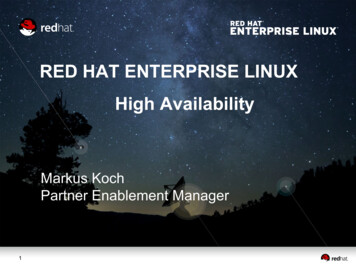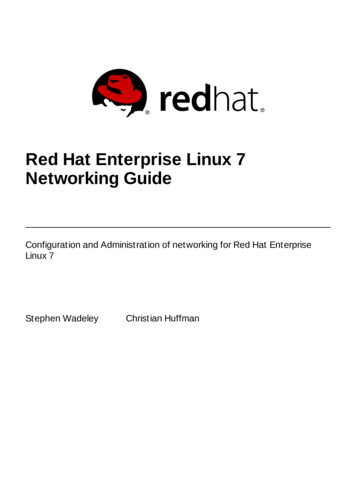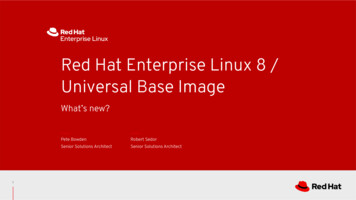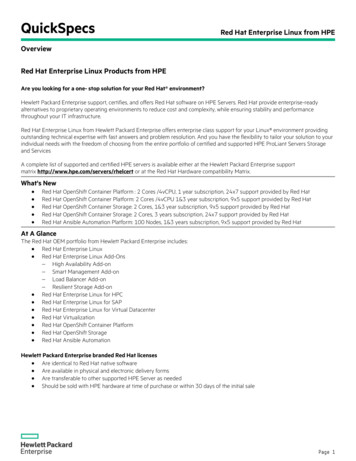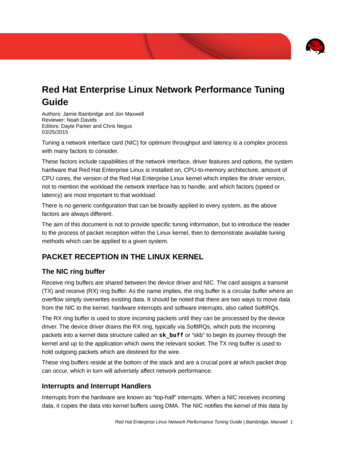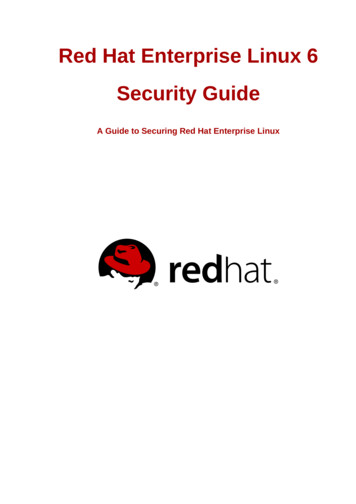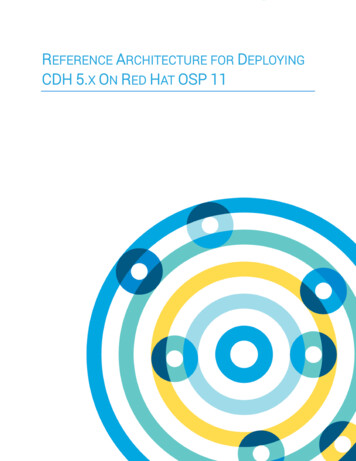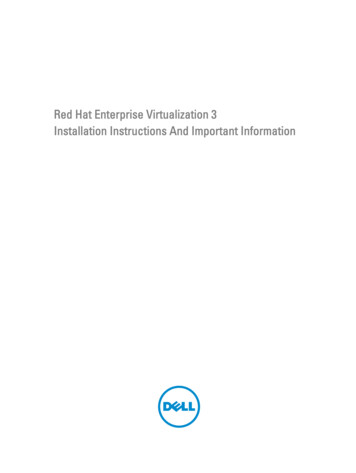
Transcription
Red Hat Enterprise Virtualization 3Installation Instructions And Important Information
Notes, Cautions, and WarningsNOTE: A NOTE indicates important information that helps you make better use of your computer.CAUTION: A CAUTION indicates either potential damage to hardware or loss of data and tells you how to avoid theproblem.WARNING: A WARNING indicates a potential for property damage, personal injury, or death.Copyright 2014 Dell Inc. All rights reserved. This product is protected by U.S. and international copyright and intellectual propertylaws. Dell and the Dell logo are trademarks of Dell Inc. in the United States and/or other jurisdictions. All other marks and namesmentioned herein may be trademarks of their respective companies.2014 - 03Rev. A04
Contents1 Installation Instructions. 5Introduction. 5Hardware Requirements.5Management Server Requirements. 5Virtualization Host Requirements.6Software Requirements. 7Operating System.7Client.7Red Hat Network Channels. 72 Important Information.9Known Issues In Red Hat Enterprise Virtualization 3.3.9DDR DMA Testing Fails In ethtool On RHEV-H 3.3. 9RHEV-H 6.5 Displays Incorrect Processor Details. 9Known Issues In Red Hat Enterprise Virtualization 3.2.9Navigating To Red Hat Network Settings Displays A Blank Red Screen .9Incorrect Details Reported For Intel Xeon E7 Processor In RHEV-H 3.2/RHEL-H 6.4.9Known Issues In Red Hat Enterprise Virtualization 3.1.10biosdevname Names SR-IOV Virtual Function From Intel rNRC As ethN. 10Unable To Configure RHEV 3.1 Home Page Setup, After Accessing It Multiple Times.10Known Issues In Red Hat Enterprise Virtualization 3.0.10Disk Description Unknown While Installing RHEV-H On SUT. 10RHEV-H 3.0 Installation Fails In UEFI Mode Using Optical Or USB Media.11RHEV 3.0 Displays Wrong Time Zone While Configuring Windows VMs.11Additional Information. 113 Getting Help.13Contacting Dell. 13Related Documentation. 13Locating Your System Service Tag.14Documentation Feedback.14
4
1Installation InstructionsIntroductionRed Hat Enterprise Virtualization (RHEV) is an end-to-end virtualization solution. RHEV 3 supports an increased numberof virtual machine resource allocations, live migration, and increased operational efficiency.NOTE: For instructions on installing RHEV 3, see docs.redhat.com.The RHEV platform contains two main components: RHEV-Manager (RHEV-M) — Provides a graphical user interface to manage the physical and logical resources ofthe Red Hat Enterprise Virtualization infrastructure. RHEV-M is installed on a Red Hat Enterprise Linux 6 server andaccessed from a client installed with a browser. The RHEV-M constitutes of:–Administration Portal — Used to setup, configure, and manage the RHEV environment.–User Portal — Used to connect to virtual machines. You can create virtual machine templates and virtualmachines from this interface.RHEV-Hypervisor (RHEV-H) — Is based on Kernel-Based Virtual Machine (KVM) virtualization technology. Toincrease operational efficiency, you can either use RHEV-H as a standalone hypervisor or integrate it with Red HatEnterprise Linux 6.2, Red Hat Enterprise Linux 6.3, Red Hat Enterprise Linux 6.4, and Red Hat Enterprise Linux 6.5.NOTE: You can download the RHEV 3 image from Red Hat Network.Hardware RequirementsTo set up a Red Hat Enterprise Virtualization environment, you require: A management server Virtualization hosts — Minimum two to support migration and power management Clients — One or more to access the Administration Portal Storage infrastructure — Provided by NFS, iSCSI, FC, or locally attached to virtualization hostsManagement Server RequirementsNOTE: The minimum and recommended requirements are for a small to a medium size installation. The exactsystem requirements may vary depending upon sizing and load.Table 1. System Requirement (Minimum)ComponentDescriptionProcessorDual coreMemory4 GBDisk space25 GB5
ComponentDescriptionNetworkOne network interface card with a bandwidth of 1GbpsTable 2. System Requirement (Recommended)ComponentDescriptionProcessorQuad core processor or multiple dual core processorMemory4 GBDisk space50 GBNetworkOne network interface card with a bandwidth of 1GbpsVirtualization Host RequirementsThis section provides information on the minimum hardware requirements to support RHEV-H and Red Hat EnterpriseLinux Hosts.ProcessorAll processors must support Intel 64 or AMD 64 processor extensions, and the AMD-V or Intel VT hardware virtualizationextensions must be enabled. Support for the No eXecute flag (NX) is also required.MemoryIt is recommended that virtualization hosts have a minimum of 2 GB RAM. The amount of RAM required varies dependingon: Guest operating system requirements Guest application requirements Memory activity and usage of guestsKVM is able to overcommit physical RAM for virtualized guests. Overcommit allows the RHEV environment to presentmore memory to guests than is actually physically present. The default overcommit ratio is 0.5.StorageVirtualization hosts require local storage to store configuration, logs, kernel dumps, and to swap space. The storagerequirements for Red Hat Enterprise Linux hosts vary based on the amount of disk space used by their existingconfiguration, but should be greater than the RHEV-H.It is recommended that each virtualization host has minimum 10 GB of internal storage comprising of: Root partition — 512 MB Configuration partition — 8 MB Logging partition — 2048 MB Swap partition — 8 MB Data partition — 256 MBNOTE: The recommended size of the swap partition depends on the system the hypervisor is being installed onand the anticipated level of overcommit for the environment.NOTE: You may not be able to upgrade the hypervisor from the RHEV-M if you use a smaller data partition. Bydefault, disk space remaining after allocation of swap space will be allocated to the data partition.6
Software RequirementsThis section lists the minimum software required to work in a Red Hat Enterprise Virtualization Environment.Operating SystemTo install: Red Hat Enterprise Linux Hypervisor, see Red Hat Enterprise Linux - Hypervisor Deployment Guide at redhat.com. RHEV-M, install Red Hat Enterprise Linux 6.x.NOTE: To use Red Hat Enterprise Linux hosts install the RHEV-M.ClientTo access the Administration Portal, you require a client with a supported web browser. The Administration Portalsupports the following clients and browsers:ClientWindows XPWindows 7 (x86, AMD64, and Intel 64)Windows 2008/R2 (x86, AMD64, and Intel 64)BrowserInternet Explorer 7 and higher on Windows, with the .NET Framework 4 installedTo access the User Portal , you need a thin client with a supported web browser. The User Portal supports the followingclients and browsers:ClientRed Hat Enterprise Linux 5.5 (i386, AMD64, and Intel 64)Red Hat Enterprise Linux 6.0 (i386, AMD64, and Intel 64)Red Hat Enterprise Virtualization Certified Linux-based thin clientsWindows XPWindows XP Embedded (XPe)Windows 7 (x86, AMD64, and Intel 64)Windows 2008/R2 (x86, AMD64, and Intel 64)Windows Embedded Standard 2009BrowserInternet Explorer 7 and higher on Windows, with the SPICE ActiveX control installedMozilla Firefox 3.5 and higher on Red Hat Enterprise Linux, with the SPICE plugin installedRed Hat Network ChannelsTo install RHEV-M, subscribe to Red Hat Network channels. These channels are used to retrieve the initial installationpackages and updates as they become available. The channels are: Red Hat Enterprise Virtualization Manager (v.3 x86 64) JBoss Application Platform (v.5) for RHEL 6 Server x86 64 Red Hat Enterprise Linux Server Supplementary (v.6 64-bit x86 64)7
8
Important Information2Known Issues In Red Hat Enterprise Virtualization 3.3DDR DMA Testing Fails In ethtool On RHEV-H 3.3DescriptionOn a RHEV-H 3.3 using the Emulex OCM14104 adapter, the Double Data Rate (DDR) DirectMemory Access (DMA) testing on the ethtool fails, when the cable is unplugged.CauseThe DDR DMA test is executed after the external loopback test. On certain physical layers theloopback test might take up to 15 seconds. The driver polls for the completion of the test for 12seconds only and the DDR DMA fails in cases where the loopback takes up to 15 seconds.RHEV-H 6.5 Displays Incorrect Processor DetailsDescriptionRHEV-H 6.5 displays the processor details incorrectly.There is no functionality loss.CauseRHEV-H 6.5 displays the virtualized processor details and not the physical processor details.Known Issues In Red Hat Enterprise Virtualization 3.2Navigating To Red Hat Network Settings Displays A Blank Red ScreenDescriptionWhen a user scrolls to the Red Hat Network option in RHEV–H 3.2 to access the configurationscreen, a blank red screen is displayed instead for a prolonged period of time.Work AroundThis issue is fixed in RHEV 3.3.CauseThe python script tries to connect to the Red Hat subscription and fails multiple times.Incorrect Details Reported For Intel Xeon E7 Processor In RHEV-H 3.2/RHEL-H 6.4DescriptionCauseDell PowerEdge servers with Intel Xeon E7 processors and RHEV-H 3.2/RHEL-H 6.4 lists thefollowing processor details incorrectly: Processor type: Intel Xeon E5 processor listed instead of Intel Xeon E7 processor. Processor sockets: One socket is listed instead of two.Hosts with multiple NUMA nodes cause incorrect information in libvirt capabilities.9
Known Issues In Red Hat Enterprise Virtualization 3.1biosdevname Names SR-IOV Virtual Function From Intel rNRC As ethNDescriptionServers installed with RHEV 3.1 and Intel Ethernet NDC controller, the biosdevname 0.3.11utility names the SR-IOV virtual functions from 10GbE port of Intel rNRC as ethN. The VFs arenamed ethN instead of the following format:em port number virtual function instance This issue affects Dell PowerEdge 12th generation platforms with on-board network adaptersNDC, which support SR-IOV when SR-IOV is enabled for the adapters.WorkaroundTo turn off the new naming convention, enter the kernel command line parameter,biosdevname 0 in the boot command line during and after installation. This issue is fixed inbiosdevname-0.4.0. For more information, see 1/.NOTE: This issue is fixed in RHEV 3.2.CauseSR-IOV virtual functions from on-board network adapters do not have SMBIOS type 41 records.To retrieve the port number, use the SMBIOS device type instance from the physical functionthat has the virtual functions.Unable To Configure RHEV 3.1 Home Page Setup, After Accessing It Multiple TimesDescriptionRHEV 3.1 home page becomes unresponsive when the setup parameters are accessed multipletimes, displaying the following error:Maximum recursion depth exceeded.CauseThe Text User Interface becomes unresponsive when you use the arrow keys to move betweendifferent pages repeatedly (over 200 times).Known Issues In Red Hat Enterprise Virtualization 3.0Disk Description Unknown While Installing RHEV-H On SUTDescriptionW
RHEV-M is installed on a Red Hat Enterprise Linux 6 server and accessed from a client installed with a browser. The RHEV-M constitutes of: – Administration Portal — Used to setup, configure, and manage the RHEV environment. – User Portal — Used to connect to virtual machines. You can create virtual machine templates and virtual machines from this interface. RHEV-Hypervisor (RHEV-H .

